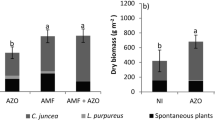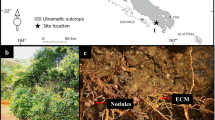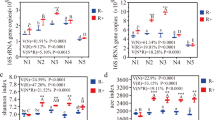Summary
In a growth chamber study we examined the influence of a plant growth-promoting rhizobacterium, Pseudomonas putida R-20, and an acid-tolerant vesicular-arbuscular mycorrhizal (VAM) fungus, Glomus intraradices 25, on Medicago sativa L. and Lotus corniculatus L. growth and nodule development. Seedlings were planted in an acidic (pH 5.5), P-deficient soil containing re-established native microflora (minus VAM) and appropriate rhizobia, and inoculated with the rhizobacterium, the VAM fungus, or both. The plants were assayed at three intervals for up to 10–11 weeks. The growth-promoting rhizobacteria alone increased alfalfa shoot mass by 23% compared to all other treatments, but only at 8 weeks of growth, apparently by promoting nodulation and N2 fixation (acetylene reduction activity). The presence of VAM, either alone or in combination with the rhizobacteria, generally decreased root length but only at 8 weeks also. As a group, the inoculation treatments increased all nodular measurements by 10 weeks of growth. Few treatment effects were found at 7 and 9 weeks for birdsfoot trefoil; neither plant nor nodular measurements differed among treatments. By 11 weeks, shoot mass was increased by the rhizobacteria alone by 36% compared to the control. As a group, the inoculation treatments all showed increased nodular responses by this time. The rhizobacteria stimulated mycorrhizal development on both plant species, but only at the initial samplings. No synergistic effects between the plant growth-promoting rhizobacterium and VAM inoculation were found. Although these results lend credence to the concept of managing microorganisms in the rhizosphere to improve plant growth, they emphasize the necessity for a more thorough understanding of microbial interactions as plants mature.
Similar content being viewed by others
References
Abelson PH (1990) Opportunities in agricultural research. Science 248:941
Azcon-G de Aquilar C, Barea JM (1978) Effects of interactions between different culture fractions in “phosphobacteria” and Rhizobium on mycorrhizal infection, growth and nodulation of Medicago sativa. Can J Microbiol 24:520–524
Azcon-G. de Aquilar C, Barea JM (1985) Effect of soil microorganisms on formation of vesicular arbuscular mycorrhizas. Trans Br Mycol Soc 84:536–537
Baligar VC, Wright RJ, Smedley MD (1988) Acid phosphatase activity in soils of the Appalachian Region. Soil Sci Soc Am J 52:1612–1616
Barea JM, Azcon-Aquilar C (1983) Mycorrhizas and their significance in nodulating nitrogen-fixing plants. Adv Agron 36:1–54
Cluett HC, Boucher DH (1983) Indirect mutualism in the legume-Rhizobium mycorrhizal fungus interaction. Oecologia (Berlin) 59:405–408
Fuhrmann J, WollumII AG (1988) Nodulation competition among Bradyrhizobium japonicum strains as influenced by rhizosphere bacteria and iron availability. Biol Fertil Soils 7:108–112
Hardy RWF, Holstein RD, Jackson EK, Burns RC (1968) The acetylene-ethylene assay for N2 fixation: Laboratory and field evaluation. Plant Physiol 43:1185–1207
Hewitt EJ (1966) Sand and water culture methods used in the study of plant nutrition Tech Commun 22, 2nd edn, revised. Commonwealth Agric Bureau, London
Linderman RG (1988) Mycorrhizal interactions with the rhizosphere microflora: The mycorrhizosphere effect. Phytopathology 78: 366–371
Manjunath A, Bagyaraj DJ (1984) Response of pigeon pea and cowpea to phosphate and dual inoculation with vesicular arbuscular mycorrhiza and Rhizobium. Trop Agric (Trinidad) 61:48–52
Meyer JR, Linderman RG (1986) Response of subterranean clover to dual inoculation with vesicular-arbuscular mycorrhizal fungi and a plant growth-promoting bacterium, Pseudomonas putida. Soil Biol Biochem 18:185–190
Mosse B (1962) The establishment of vesicular-arbuscular mycorrhiza under aseptic conditions. J Gen Microbiol 27:509–520
Olsen SR, Sommers LE (1982) Phosphorus. In: Page AL, Miller RH, Keeney DR (eds) Methods of soil analysis: Part 2, Chemical and microbiological properties, 2nd edn. Am Soc Agron, Madison, Wisconsin, pp 416–418
Rouatt JW, Katznelson H, Payne TMB (1960) Statistical evaluation of the rhizosphere effect. Soil Sci Soc Am J 24:271–273
Rovira AD (1965) Interactions between plant roots and soil microorganisms. Annu Rev Microbiol 19:241–266
Rovira AD, Davey CB (1974) Biology of the rhizosphere. In: Carson EW (ed) The plant root and its environment. University Press of Virginia, Charlottesville, VA, USA, pp 153–204
SAS Institute (1982) User's guide: Statistics. SAS Institute, Gary, North Carolina
Staley TE, Wright RJ (1991) Inoculation responses of perennial forage legumes grown in fresh hill-land ultisols as affected by soil acidity related factors. J Plant Nutr 14:599–612
Subba Rao NS, Tilak KVBR, Singh CS (1986) Dual inoculation with Rhizobium sp and Glomus fasciculatum enhances nodulation, yield and nitrogen fixation in chickpea (Cicer arietinum Linn.). Plant and Soil 95:351–359
Vincent JM (1974) Root nodule symbioses with Rhizobium. In: Quispel A (ed) Biology of nitrogen fixation. American Elsevier Publishing, New York, pp 265–341
Weller DM (1988) Biological control of soilborne plant pathogens in the rhizosphere with bacteria. Annu Rev Phytopathol 26:379–407
Wright RJ, Wright SF (1987) Effects of aluminum and calcium on the growth of subterranean clover in Appalachian soils. Soil Sci 143:341–348
Author information
Authors and Affiliations
Rights and permissions
About this article
Cite this article
Staley, T.E., Lawrence, E.G. & Nance, E.L. Influence of a plant growth-promoting pseudomonad and vesicular-arbuscular mycorrhizal fungus on alfalfa and birdsfoot trefoil growth and nodulation. Biol Fertil Soils 14, 175–180 (1992). https://doi.org/10.1007/BF00346058
Received:
Issue Date:
DOI: https://doi.org/10.1007/BF00346058




